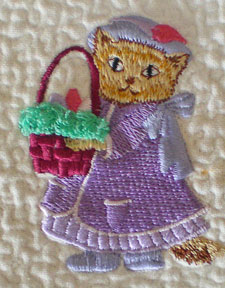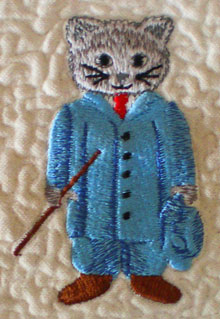This post contains affiliate links for which I receive compensation
Stabilizers for machine embroidered quilts
I am doing an embroidery quilt with a lot of stitches. The tear away stabilizer is good, but I cannot get all of the stabilizer torn away and it seems to heavy to leave in the quilt. I am doing the embroidery before putting the quilt together.
Any assistance will be appreciated.
Reply
I have used machine embroidery designs on two quilts. Both for my kids. Both made with flannels and homespuns. I've also embroidered quilt blocks (not labels) for baby quilts that include name, birthdate, height and weight in my customizing program for my Viking sewing machine. Just like you, I embroidered the blocks before stitching them into my quilt.
The tricot is really light and doesn't effect the 'hand' of the fabric. I didn't expect the interfacing to shrink (because it's a man made fiber). I knew the flannel would shrink so I prewashed it.
I also took care to find the lengthwise grain of both the flannel and the interfacing.
To get the most 'stabilization' I fused the interfacing to the squares so that the lengthwise grains ran perpendicular to each other...the lengthwise grain of the block runs top to bottom, that of the interfacing square runs left to right.
Next I hooped a paper backed sticky stabilizer and pressed the prepared fabric squares to it and did the embroidery.
Since these were both intended as 'kid' quilts and consumable (because of the flannel) I didn't really care if any remnants of the paper backed sticky remained. The quilts weren't intended to last to the next generation.

Once the design is stitched, cut away the excess with a pinking shear to 'feather' the edges of the cutaway. That way you won't have an unsightly hard edge showing from the front. (And you won't have any tearaway paper still embedded in your design and ultimately your quilt.)
Now if your design is dense with stitches like my little kitties, you'll need to add plenty of quilting to the background. Those stitches will hold the layers in place and minimize the poof.
Dense embroidery designs can look like a 'pillow' sitting on top of the quilt. The extra background fill makes them look 'normal'. (I wish I had a better word than that.) The designs don't puff up as much.
While you can't see it from the pictures, there IS ditch quilting around the embroidery to help make it part of the quilt, instead of looking like it's sitting on top.
The extra stitching also seemed to minimize the 'heaviness' of the dense kitty embroideries. The quilts I made were still 'cuddly'.
To my machine embroidering readers, your thoughts and experiences are most welcome. Please share them using the 'Comments' link found just below to help with this question.
Thank you!
Piecefully,
Julie Baird
Editor
Comments for Stabilizers for machine embroidered quilts
|
||
|
||















